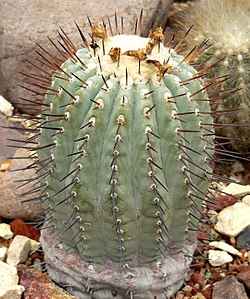| Notocacteae | |
|---|---|
 | |
| Parodia werneri | |
| Scientific classification | |
| Kingdom: | Plantae |
| Clade: | Tracheophytes |
| Clade: | Angiosperms |
| Clade: | Eudicots |
| Order: | Caryophyllales |
| Family: | Cactaceae |
| Subfamily: | Cactoideae |
| Tribe: | Notocacteae |
| Type genus | |
| Notocactus | |
| Genera | |
See text | |
Notocacteae is a tribe of cacti belonging to the subfamily Cactoideae. [1] It is one of the oldest cactus lineages endemic to South America. [2]





